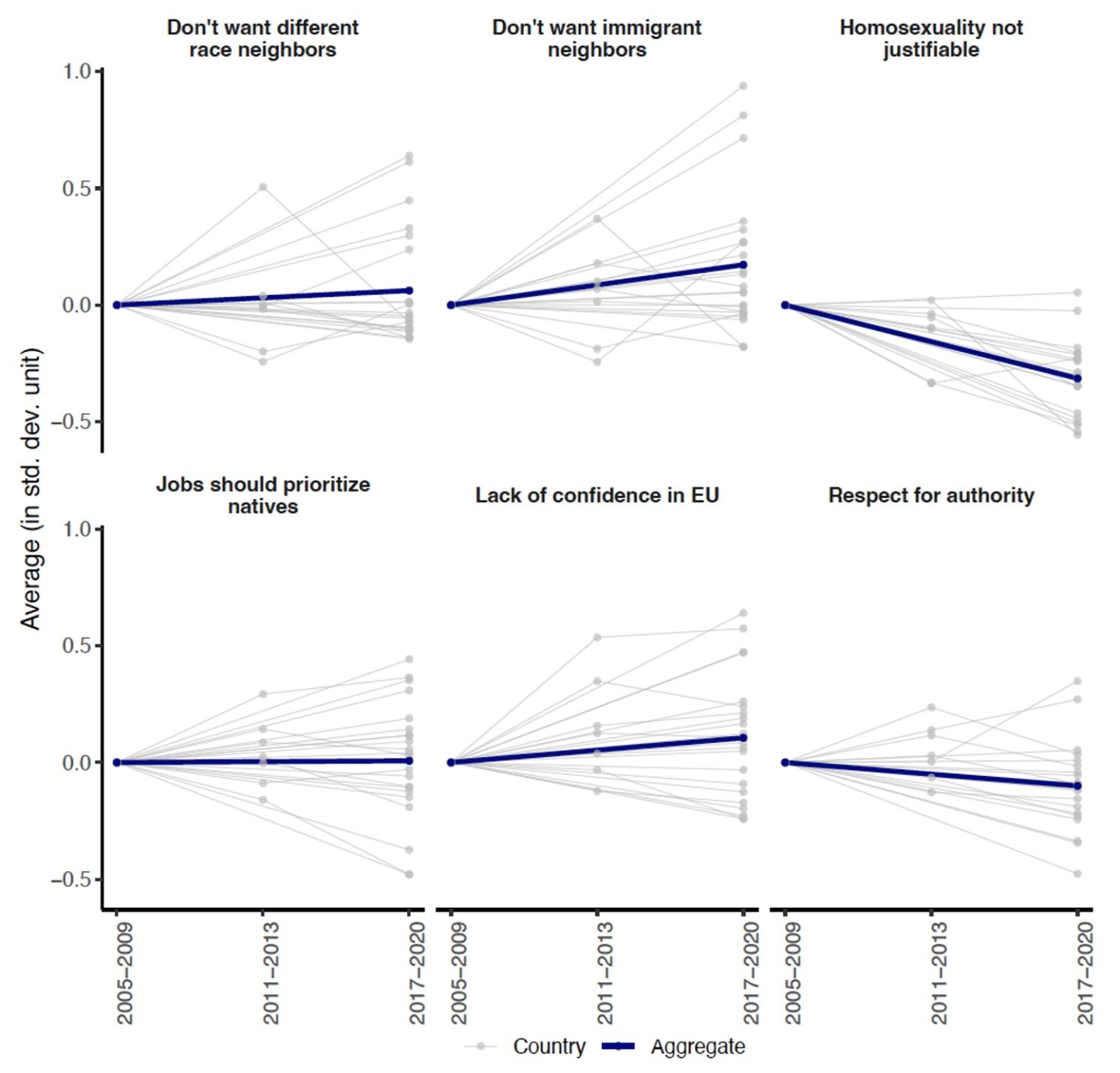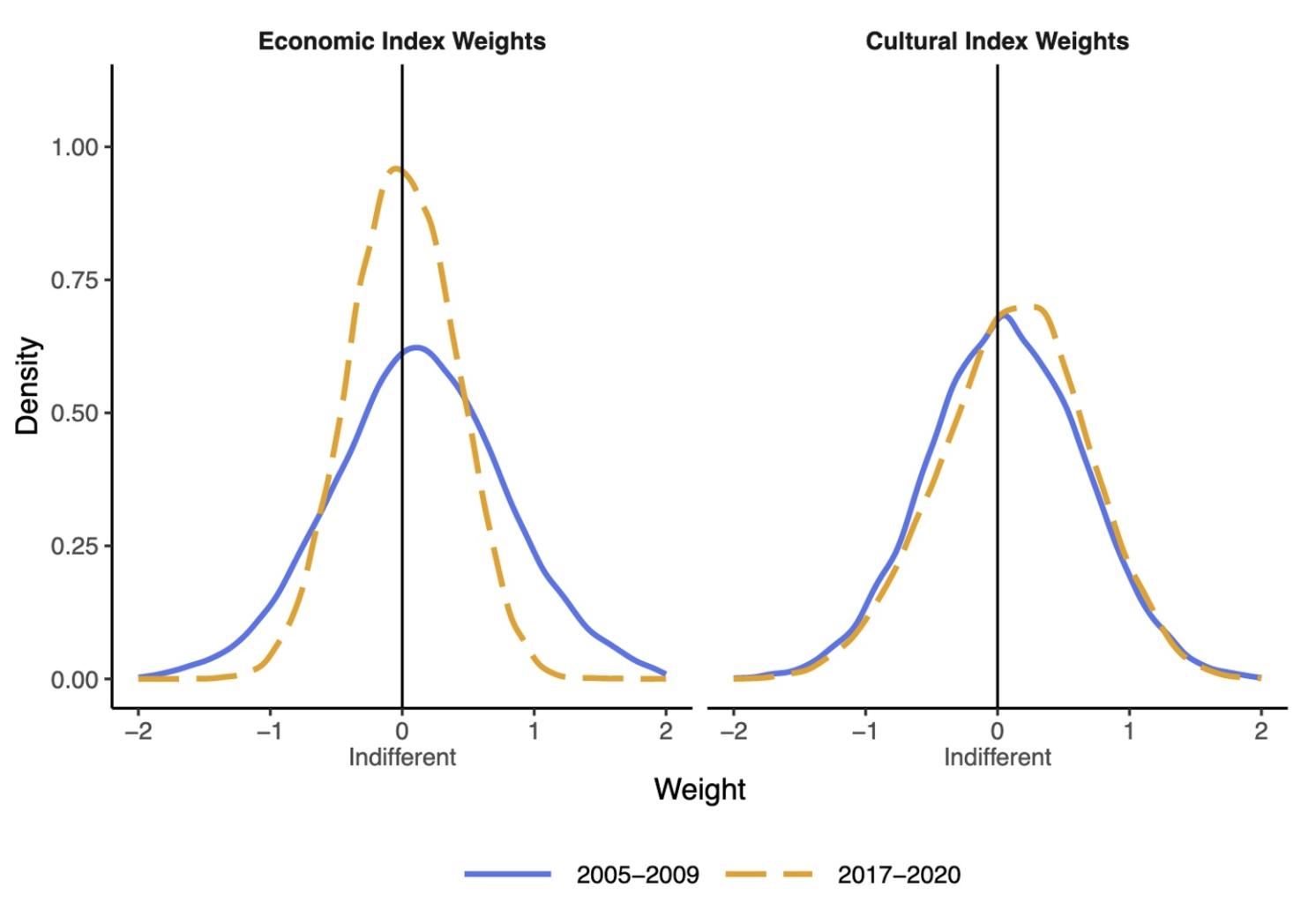Yves here. This post provides an important insight to the rise in influence of the much-demonized non-corporate right wing: that its success results significantly from voters not changing their beliefs per se, but changing which issues they weigh heavily when selecting parties and candidates. We can see the liberal version of that process here in the US, when the rollback of Roe v Wade led many voters to greatly increase the importance of voting rights in their decision whether and how to vote.
This finding also helps explain why voting patterns tend to shift to the right in the wake of economic crises. Those lower in the social/employment pecking order were already in a more precarious position. If social safety nets don’t provide enough help, they often rely on family or religious group support. It’s also not hard to see that more desperate personal circumstances would lead to resentment of competition from immigrants.
By Oren Danieli, Assistant Professor, School of Economics Tel Aviv University; Noam Gidron, Senior Lecturer Hebrew University of Jerusalem; Shinnosuke Kikuchi; and Ro’ee Levy Senior Lecturer, School of Economics Tel Aviv University. Originally published at VoxEU
Support for populist radical right parties has increased dramatically across Europe. This column looks at drivers of the rise of the populist right between 2005 and 2020and finds that the primary driver in Europe is changing priorities of voters rather than changes in party position or voter attributes. Older, non-unionised, less-educated men are particularly, and increasingly, inclined to prioritise nationalist cultural issues over a party’s economic positions.
Across Europe and beyond, the populist radical right is gaining traction. Populist radical right parties have not only increased their share of the vote – they also join coalitions more often and in some cases lead governments. As discussed in various columns on Vox, this comes with a price: populists in power negatively affect growth and erode stability (Schularick et al. 2022). It is no wonder that a large body of scholarship across the social sciences seeks to identify the drivers of growing support for the populist right (Tabellini 2019, Rooduijn 2019, Cremaschi et al. 2023).
Three narratives regarding the rise of the populist radical right emerge from this body of scholarship. One narrative suggests that changes in parties’ positions – for instance, the convergence of mainstream parties around a similar ideological programme – explain why the populist radical right attracts growing support (e.g. Berman and Kundnani 2021). According to the second narrative, public opinion has shifted in nativist and authoritarian directions – the directions that benefit the populist radical right – following economic shocks and exposure to immigrants (e.g. Hangartner et al. 2019, Ballard-Rosa et al. 2021). Yet a third narrative proposes that public opinion has not changed drastically;¬ instead, it is voters’ priorities that shifted (Bartels 2017, Bonikowski 2017). Based on this hypothesis, votes may change even if voters’ attitudes remain the same. For example, imagine a voter who always opposed immigration but did not much care about the issue. As immigration comes to carry more weight, this voter may gravitate toward the populist radical right even without changing her mind on the topic.
How much of the rise of the populist radical right in Europe does each of these factors – change in party positions, change in voters’ attitudes, and change in voters’ priorities – account for? This is the question we explore in a recent paper (Danieli et al. 2022). We combine information on partisan positions from the Comparative Manifesto Project with data on voters’ attitudes as captured in the Integrated Values Surveys collected from 2005 to 2020. We estimate priorities based on a probabilistic voting model.
We analyse this rich dataset using a decomposition method adopted from labour economics (Fortin et al. 2011). The decomposition approach allows us to gauge how much support for the populist radical right would change when letting only one factor change and holding constant the other factors. This is what we find.
Decomposition Results
Figure 1 summarises the results of the decomposition analysis. The y-axis shows what percentage of the aggregated rise in support for populist radical right parties is generated by changes in party positions, changes in attitudes, and changes in priorities. We add a residual category for the entry of new parties and for other factors we cannot capture with our data (e.g. the quality of these parties’ leadership). On the x-axis, we divide our data into three time periods based on the years in which the surveys were fielded.
We first observe that changes in party positions explain very little of the changing support for the populist radical right within the time period covered in our data. The action takes place on the side of voters, but not so much in voters’ attitudes as in their priorities.
Figure 1 Decomposition results
Changes in voters’ attitudes explain only a small share – about 7% – of the rise in support for the populist radical right. This is an important corrective to a common claim in the media that there “has been a slide to the right” in public opinion (Mallet 2022). To further examine this issue, Figure 2 investigates changes in attitudes on cultural issues that often feature in populist radical right campaigns. Higher positive values on the y-axis denote more conservative attitudes. Each grey line represents one country and the blue line represents aggregated public opinion across countries. Clearly, there is no unison conservative turn: if anything, on some issues, public opinion has become more progressive. Scholars, media observers and political operatives should not be quick to accept the claim that public opinion is moving in the direction of the populist radical right.
Figure 2 Change in attitudes

How Priorities Have Changed
While attitudes have not changed dramatically on most issues, what have changed are voters’ priorities. This is by far the strongest result of our decomposition analysis: changes in priorities explain around 45% of the increase in support for the populist right according to our analysis.
To more closely examine which issues gained priority, we distinguish between economic and cultural policy domains. Economic issues deal with the question of ‘who gets what’, while cultural issues are those that more directly pertain to the question of ‘who we are’. While far from perfect, this distinction follows previous research on populism (Margalit 2019).
Figure 3 traces changes over time in the estimated weights voters attach to economic and cultural issues. Positive weights imply support for right-wing positions, while negative weights imply support for left-wing positions. The further away voters are from zero on the x-axis, the stronger an issue weighs on their voting decision. For economic issues, we see that over time the distribution of weights has become more narrowly concentrated around zero – that is, more voters are increasingly indifferent to economic policies. In contrast, we see a right-ward turn in the distribution of weights on the cultural dimension. This means that a growing number of voters now put more weight on culturally conservative positions when voting. But who are these people whose vote choice is increasingly shaped by their cultural attitudes?
Figure 3 Change in weights

This change in priorities has not been homogenous across the population. In additional analyses reported in our paper, we find that conservative cultural issues now more strongly shape the voting decisions of men, those without a college degree, those who are not unionised, older individuals, and those who reside in rural areas. It is not surprising that previous analyses have located these groups at the core of the electoral coalition supporting the populist radical right.
Political Change Through Change in Priorities
What does this all boil down to? When we see parties gain support, it is easy to assume that this is because public opinion is moving in their direction. But our work suggests this is not necessarily the case. Electoral upheavals may follow not only a change in attitudes but also a change in priorities, which is what we find in our analysis of support for the populist radical right.
The degree to which our findings travel outside of Europe is an important topic for future research. There is some evidence that in the US, support for Donald Trump should be understood on the background of changing priorities (Sides et al. 2022) and the activation of pre-existing worldviews (Mason et al. 2021). Whether the same applies to non-Western cases of populism – for instance, Brazil – is yet to be explored. While our work focuses on Europe, our decomposition tools could be used in other cases to expand the scope of the comparative conversation on support for the populist radical right.
More broadly, our work underscores the importance of political priorities. We still have limited understanding of how priorities change – and how to theorise and empirically capture those changes. We hope our study guides future research into the drastic shift in priorities over the last couple of decades that we uncover in our work.
See original post for references


